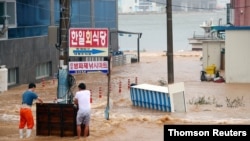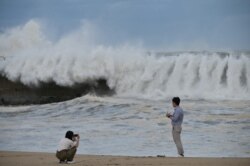A powerful typhoon was barreling up the already soaked Korean Peninsula Monday, toppling trees, causing small landslides and knocking out power to thousands of South Koreans before taking aim at flood-prone North Korea.
Around 17,000 South Korean homes lost electricity and at least 48 structures were destroyed across the country, as Typhoon Haishen - meaning "sea god" in Chinese - made landfall in the southeastern city of Ulsan and moved northward up the east coast.
Television broadcasts showed flooded streets and overflowing rivers in the southern tip of South Korea. Local broadcaster KBS reported small landslides near apartment buildings on Geoje Island off the southeast coast.
South Korean officials have not reported any deaths. However, at least four people were missing, and dozens were injured after the storm swept through southern Japan, according to local media. Around 300,000 Japanese homes were without power as of Monday afternoon.
Later Monday, Haishen is expected to pummel North Korea, which is still recovering from another major typhoon last week. The storm is set to make landfall in the northeastern port city of Chongjin, North Korea’s third largest city.
Ahead of the typhoon, North Korean state television broadcast live reports showing waves striking the shore in Tongchon County, which borders South Korea. Residents there who live near the shore have been evacuated, state TV said.
Haishen is much bigger than Typhoon Maysak, which battered North Korea last week. According to North Korean state media, Maysak destroyed more than 1,000 dwellings and caused dozens of casualties.
The Korean Peninsula usually sees just one typhoon per year but has been hit by three in the past two weeks. The situation has been made worse by a historically wet monsoon season, which ended last month. At one point this summer, South Korea saw 49 consecutive days of rain.
The storms are especially dire for North Korea, which is vulnerable to flooding. The country lacks adequate infrastructure and suffers from widespread deforestation, resulting in part from people cutting down trees for fuel or firewood or to clear land for farming.
Media in North Korea - a tightly controlled, quasi-Stalinist state - are not usually transparent about natural disasters or other calamities. State television usually only broadcasts prepackaged reports during a set schedule.
But during recent storms, North Korean state TV has been more flexible, sometimes even airing live reports during the overnight hours.
On Sunday, state media reported that North Korean leader Kim Jong Un visited an area recently hit by Typhoon Maysak and fired a top local official there.
The storms are an added stress for impoverished North Korea, which is already dealing with a sagging economy because of the coronavirus pandemic and international sanctions over its nuclear program.

